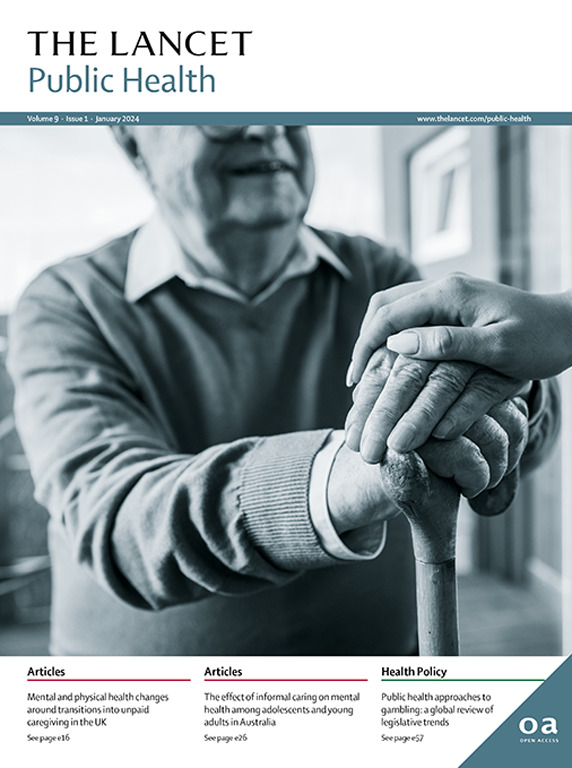Socioeconomic inequalities in life expectancy in Australia, 2013–22: an ecological study of trends and contributions of causes of death
IF 25.2
1区 医学
Q1 PUBLIC, ENVIRONMENTAL & OCCUPATIONAL HEALTH
引用次数: 0
Abstract
Background
Despite having one of the highest life expectancies in the world, Australia has considerable subnational variation in health. Our aim was to examine contemporary trends in area-based socioeconomic inequalities in life expectancy, including age-specific and cause-specific components.Methods
In this ecological study, we used individual death records and estimated resident population (ERP) to calculate life expectancy and cause-specific life-years lost for each decile of the Australian Bureau of Statistics (ABS) Index of Relative Socio-Economic Advantage and Disadvantage (IRSAD) for the whole population in Australia for 2013–22. We used the ABS Death Registrations data in the Person Linked Integrated Data Asset for individual-level records on all deaths that occurred and were registered in Australia, including year of death, age, sex, underlying cause of death, and Statistical Area Level 2 (SA2). We excluded death records in which SA2 was unknown and deaths and ERPs for people living in SA2 where IRSAD could not be defined due to small population counts. We measured inequality by the Slope Index of Inequality (SII) and the absolute gap between the most advantaged (D10) and most disadvantaged (D1) deciles.Findings
Socioeconomic inequalities in life expectancy widened before reaching a maximum in 2016–18 at SII 4·7 years (95% CI 4·4–5·0) for females and in 2017–19 for males (6·8 years [6·4–7·1]), reflecting little improvement or even deterioration in life expectancy in the more disadvantaged areas. During the COVID-19 pandemic (from 2020) inequalities continued to narrow for males (they had begun to narrow just before the pandemic) but widened for females, largely due to COVID-19 mortality. The effect of other causes of death varied over time and differed by sex, with ischaemic heart disease, lung cancer, and chronic obstructive pulmonary disease consistently being the largest contributors to life expectancy inequalities.Interpretation
Socioeconomic inequalities in life expectancy in Australia were larger in 2020–22 than in 2013–15, despite some reductions just before and during (for males only) the COVID-19 pandemic. Sustained public health efforts to prevent and manage specific chronic conditions, as well as to reduce premature mortality from injuries (particularly suicide and traffic accidents) and substance misuse among populations in the most disadvantaged areas are needed to reduce socioeconomic inequalities in life expectancy and further increase longevity in AustraliaFunding
Australian Research Council.2013-22年澳大利亚预期寿命的社会经济不平等:死亡原因趋势和贡献的生态学研究
背景尽管澳大利亚是世界上预期寿命最高的国家之一,但在健康方面,澳大利亚的地方差异很大。我们的目的是研究基于地区的预期寿命社会经济不平等的当代趋势,包括特定年龄和特定原因的组成部分。方法在这项生态研究中,我们使用个人死亡记录和估计常住人口(ERP)来计算2013-22年澳大利亚统计局(ABS)相对社会经济优势和劣势指数(IRSAD)中每个十分位数的预期寿命和原因特异性生命年损失。我们使用个人关联综合数据资产中的ABS死亡登记数据获取澳大利亚发生和登记的所有死亡的个人记录,包括死亡年份、年龄、性别、潜在死亡原因和统计区域2级(SA2)。我们排除了SA2未知的死亡记录,以及由于人口数量少而无法定义IRSAD的SA2人群的死亡和erp。我们通过不平等斜率指数(SII)和最有利的(D10)和最不利的(D1)十分位数之间的绝对差距来衡量不平等。研究发现,预期寿命方面的社会经济不平等在2016-18年达到最大值,女性为SII 4.7岁(95% CI 4.4 - 5·0),男性为2017-19年(6.8岁[6.4 - 7.1]),反映出较弱势地区的预期寿命几乎没有改善,甚至有所恶化。在2019冠状病毒病大流行期间(从2020年开始),男性的不平等现象继续缩小(在大流行之前开始缩小),但女性的不平等现象扩大,主要是由于COVID-19死亡率。其他死亡原因的影响因时间和性别而异,缺血性心脏病、肺癌和慢性阻塞性肺病一直是造成预期寿命不平等的最大因素。澳大利亚预期寿命方面的社会经济不平等在2020-22年比2013-15年更大,尽管在2019冠状病毒病大流行之前和期间(仅针对男性)有所减少。为了减少澳大利亚预期寿命方面的社会经济不平等,并进一步延长澳大利亚研究理事会的寿命,需要在公共卫生方面作出持续努力,预防和管理特定的慢性病,减少最不利地区人口因受伤(特别是自杀和交通事故)和药物滥用而过早死亡。
本文章由计算机程序翻译,如有差异,请以英文原文为准。
求助全文
约1分钟内获得全文
求助全文
来源期刊

Lancet Public Health
Medicine-Public Health, Environmental and Occupational Health
CiteScore
55.60
自引率
0.80%
发文量
305
审稿时长
8 weeks
期刊介绍:
The Lancet Public Health is committed to tackling the most pressing issues across all aspects of public health. We have a strong commitment to using science to improve health equity and social justice. In line with the values and vision of The Lancet, we take a broad and inclusive approach to public health and are interested in interdisciplinary research.
We publish a range of content types that can advance public health policies and outcomes. These include Articles, Review, Comment, and Correspondence. Learn more about the types of papers we publish.
 求助内容:
求助内容: 应助结果提醒方式:
应助结果提醒方式:


